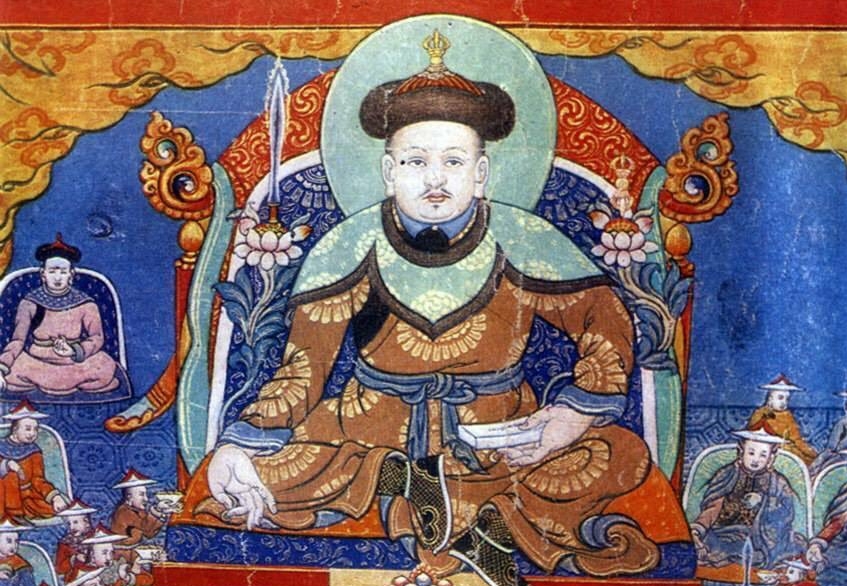Gaining control of the southern part of Mongolia had not been much trouble for the Manchu. But it would take them more than fifty years to do the same with the Halh, and more than a hundred years to subjugate the Oirad. The Manchu army alone could not conquer Mongolia. Therefore, the Qing, in addition to relying on military force, resorted to Chinese craftiness and Tibetan religion in their diplomacy with Mongolia.
The Source
Guyuk Khan’s brother Godon invited the first Sakya monk in 1247, while he was the Mongolian military commander at Hoh Nuur. At this time the Mongols had built their enormous empire and needed a monolithic religion to help them consolidate their power.
Before his death, Genghis Khan had given preference to Taoism, and Guyuk Khan was sympathetic towards Christianity. But Godon and some other leaders were attracted to Tibetian Buddhism because of its teaching on the union between religion and the state. Godon’s goal was to unite his state under a single religion.
Seeing this opportunity, many rival schools of Tibetian Buddhism competed with one another to win the support of the mighty Mongol rulers. The Karma Kagyu school was the one welcomed during Mongke Khan’s time. Its temple was built in the imperial capital side by side with Christian, Muslim and Taoist places of worship.
The Continuation
Kublai Khan was one of the most highly-educated nomads and, in his childhood, he became a student and a follower of Chan Buddhism. But Chan was too intellectually refined and complex for his nomads to accept. Tibetan Buddhism, however, was not so sophisticated and of greater pragmatic value, with its idea of the unity of state and religion. And so, in 1260, Kublai Khan invited Phagra, the head lama of the Sakya, school and, in his so-called “pearl decree,” he made public his decision to make this the state religion. Receiving from Kublai the title of State Preceptor, the Phagra lama spent many years beside the Khan, teaching his religion to the Mongol nobility.
Fading Away
Even though this Tibetan religion failed to expand beyond the Mongol community in Beijing, the Tibetan clergy had won themselves, powerful patrons. For a hundred years, the Yuan Dynasty rulers brought in Sakya lamas and bestowed on them the title of State Preceptor. It was State Preceptor Choji Oser who developed new rules for the Uighur-based script of the Mongols reformed it into the one that is still used today. Following the collapse of the Yuan Dynasty, the Buddhist zeal of the Mongols petered out along with the absolute domination of Sakya. Meanwhile, the feud between religious schools in Tibet continued, causing tension and instability.
The Contribution of the Mongols
When Sonam Gyamtso arrived at Huh Nuur, Altan Khan conferred on him the title of Dalai Lama and handed him a seal of gold-bearing the words, “Seal of Vajra Dalai Lama” inscribed in the Square Script. In return, he received the title of “King of Mind, Heaven-sent Great Power.”
Tibetans believed in the reincarnation of holy personages. Tsongkhapa instructed that his next reincarnation not be recognized. Following his request, the Gelugpa established the next reincarnation of his student Genden Drup. Thus, Sodnom Gyamtso declared himself as the third Dalai Lama and became the reincarnation of Gengun Drup, who had died sixty-nine years earlier.
Tsongkhapa’s school borrowed the idea of reincarnated religious leader from the Karma Kagyupa or “Black Hats” School. Karma Pakshi (1204-83), one of its leaders, called on the great khan Kublai in the Karakorum, and was given a black hat. Dying in 1283, Karma Pakshi was said to have been reincarnated the next year in the shape of Rangjung Dorje (1284-1339) and assumed his place at the head of the Black Hat lineage.
Sonam Gyamtsho, who had thus won the support of Mongol khans and other nobles, said before his death that he would be reborn in Mongolia, apparently showing his desire to secure the continuation of this support beyond his own lifetime. He kept his promise and was born again in Mongolia as the great-grandson of Altan Khan. In this way, Mongolia was blessed with its own Dalai Lama.
Unfortunately, the fourth Dalai Lama Yonten Gyamtsho did not live long, for he was killed at twenty-eight, after fourteen years in Tibet.
Chronology
- 1357: The founder of the Yellow or Geluk school of Buddhism Tsongkhapa was born.
- 1391: The first Dalai Lama Gendun Drup was born.
- 1575: The leader of the Gelukpa, Sodnom Gyamtso, visited Mongolia and converted Altan Khan to Buddhism.
- 1576: Tumen Zasagt Khan invited Karma Pakshi, the leader of the Karma Kagyu school.
- 1578: May 15th Altan Khan welcomed Sodnom Gyamtsho from Tibet, and declared Buddhism the state religion.
- 1579: A temple was built in Huh Hot. The Altangerel sutra was translated from Tibetan by Altan khan’s decree.
- 1581: Avtai Sain Khan (1554-1588) established a relationship with senior Tibetan lamas.

